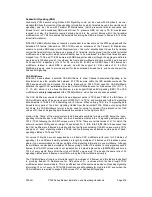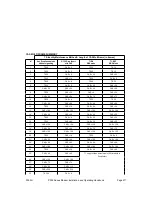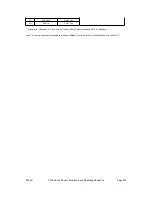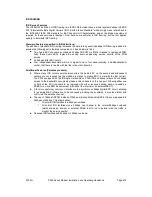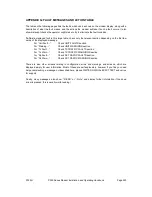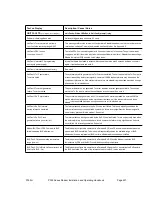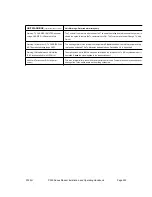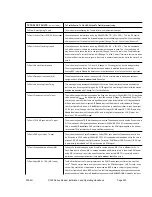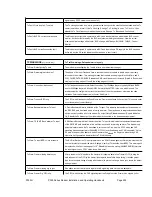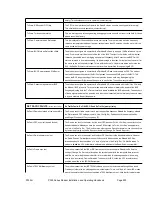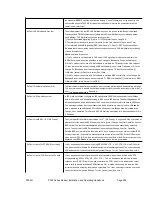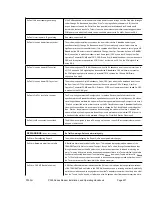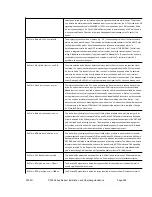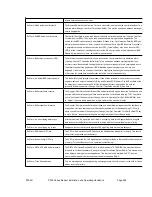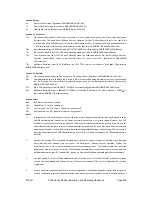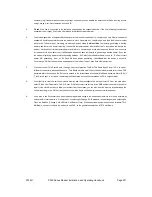
P300H
P300 Series Modem Installation and Operating Handbook
Page 230
Actions: Relays
U =
Prompt Unit Fault relay. [Equivalent to SMS/IBS/IDR AE/AS1/AS1]
T =
Prompt Traffic Fault relay. [Equivalent to SMS/IBS/IDR AE/AS1/AS1]
D =
Deferred Alarm relay. [Equivalent to SMS/IBS/IDR none/AS2/AS2]
Actions: To Terrestrial
TA =
AIS (all ones) in selected TS if the Insert mux is active, AIS over all data if not in Insert mode. If Insert mode is active and
the user control Thin Route Spoof (Change, User opt, Operation, Terr/Sat, Thin Route Spoof) is set to On , then AIS is
forced over the whole PCM bearer, not just the selected timeslots to spoof full bearer connectivity when passed over a
Thin Route satellite circuit (ie not the whole bearer data rate). [Equivalent to SMS/IBS/IDR AH1&AH3/AH1/AH1]
TB =
Frame Backward Alarm (in PCM Multiplex, eg G.732 TS0-NFAS bit 3). [Equivalent to SMS/IBS/IDR AH2/AH2/none]
TC =
AIS (all ones) forced in the G.732 CAS `abcd` signalling nibble. Equivalent to SMS/IBS/IDR AH4/AH3/none]
TD =
Force a fixed value in the G.732 CAS `abcd` signalling nibble. The fixed value is set by user control (Change, User Opt,
Operation, Actions, Back Alarm) to be either No-Action, b=1, a=b=1, a=b=c=d=1. [Equivalent to SMS/IBS/IDR
AH5/none/none]
TE =
Multiframe Backward Alarm (in PCM Multiplex, eg G.732 TS16 frame 0 of multiframe = 0000 1111). [Equivalent to
SMS/IBS/IDR AH6/none/none]
Actions: To Satellite
SB =
Frame Backward Alarm (in IBS/SMS this is direct, in IDR or when multiple backward alarms are active it corresponds to
the Rx Summary Fault Output which is externally patched back into the Backward Alarm inputs). [Equivalent to
SMS/IBS/IDR AK2/AD2/AD2]
SA =
AIS (all ones), framed and scrambled ad subject to RS coding if active. [Equivalent to SMS/IBS/IDR AK1/AD1/AD1]
SC =
AIS in CAS signalling carried in IBS/SMS TS16/TS48 over satellite. [Equivalent to SMS/IBS/IDR AK3/AD3/none]
SD =
Multiframe Backward Alarm in IBS/SMS TS16/TS48 over satellite (TS16 frame 0 of CAS multiframe = 0000 1111).
[Equivalent to SMS/IBS/IDR none/none/none]
Actions: Other
BM=
BUC Mutes (not a modem function)
CM =
Carrier Mute, Tx carrier is switched off
TF =
Tx Flow control, the `CTS` (Clear To Send) line is switched off
RF =
Rx Flow control, the `RR` (Receiver Ready) line is switched off
Notes
1:
In response to a CAS multiframe sync loss from the terrestrial port, the appropriate alarm to raise would appear to be the
CAS-MF backward alarm. However as the bearer is normally looped there is no point in raising this alarm, as a CAS
multiframe is required to convey it (ie the presence of the fault prevents the return alarm being sent). There are only two
circumstances where the return bearer is not dependent upon the bearer into the Insert Mux, either when the Insert Mux
is generating the bearer, or when the Rx path is receiving an independent 2M stream, which contain a CAS multiframe. In
these two circumstances the CAS-MF backward alarm is sent (TE), in all other circumstance the TS0 backward alarm is
sent (TB).
2:
Normally, an incoming TS16 Multiframe backward alarm causes the modem to transmit a Satellite Frame Backward
Alarm (SB) to be sent. However if the user control Thin Route Spoof (Change, User opt, Operation, Terr/Sat, Thin
Route Spoof) is set to On to spoof full bearer connectivity when passed over a Thin Route satellite circuit (ie not the
whole bearer data rate), then an incoming TS16 Multiframe backward alarm causes the modem to transmit a Satellite
Multiframe Backward Alarm (SD, instead of SB) to keep the Frame and Multiframe backward alarm functions separate.
3:
Line code setting: For P1431/32 cards
check
the switch on the card itself. For P1440/41/42 cards, which are configured
from the front panel
check
with Change, Terr-Int, Electrical, then reselect G.703, which is followed by the line code
configuration.
4:
All ones (the Alarm Indication Signal, AIS) is a means of signalling to downstream equipment that the data being sent is
not valid. It is advised to leave AIS detection enabled so the modem can inform you when there is a fault with the traffic. If

